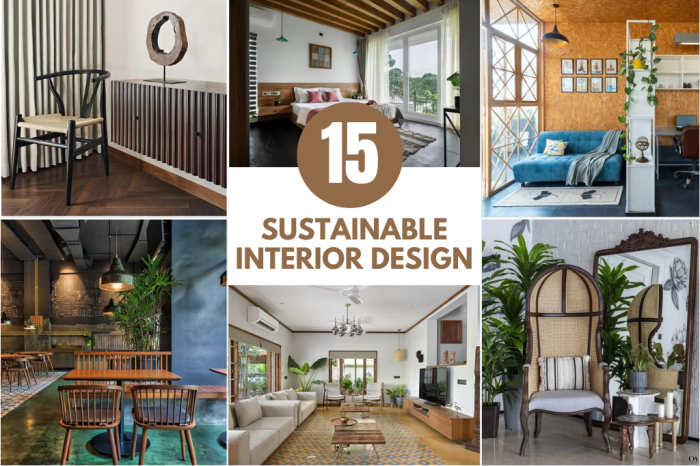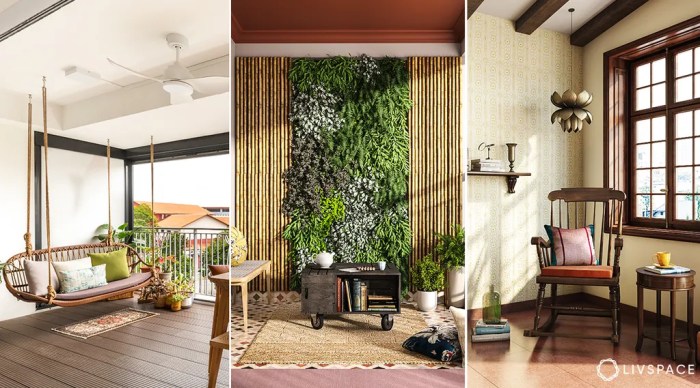Embark on a journey towards sustainable living through the lens of interior design. Discover how small changes in your living space can make a big impact on the environment and your well-being.
Explore the world of sustainable materials, energy-efficient lighting solutions, indoor air quality improvement, and furniture choices that align with a greener lifestyle.
Importance of Sustainable Interior Design

When it comes to interior design, incorporating sustainable practices is not only beneficial for the environment but also for human health. By using eco-friendly materials and techniques, we can reduce our carbon footprint and create healthier living spaces.
Benefits of Sustainable Interior Design
- Improved Indoor Air Quality: Sustainable materials such as low-VOC paints and natural fibers help reduce harmful emissions and toxins in the air, promoting better respiratory health.
- Energy Efficiency: Using energy-efficient appliances and lighting can help lower utility bills and reduce overall energy consumption.
- Waste Reduction: Opting for recycled or upcycled materials in interior design can help minimize waste and promote a circular economy.
Examples of Sustainable Materials and Techniques
- Bamboo: A fast-growing, renewable resource that can be used for flooring, furniture, and decor.
- Recycled Glass: Eco-friendly option for countertops, tiles, and decorative accents.
- Solar Panels: Harnessing renewable energy for powering homes and reducing reliance on non-renewable sources.
Impact of Sustainable Interior Design
- Environmental Preservation: Sustainable interior design helps conserve natural resources and reduces the negative impact on ecosystems.
- Healthier Living Spaces: By avoiding toxic materials and promoting better indoor air quality, sustainable design contributes to the well-being of occupants.
- Long-Term Cost Savings: While initial investment in sustainable design may be higher, the long-term savings on energy bills and maintenance costs outweigh the upfront expenses.
Sustainable Material Selection
When it comes to sustainable interior design, choosing the right materials is crucial. Not only do eco-friendly materials help reduce environmental impact, but they also promote a healthier living environment for occupants.
Eco-Friendly Materials
- Bamboo: Known for its fast growth and renewability, bamboo is a popular choice for flooring, furniture, and decor items. It is durable, versatile, and adds a natural touch to any space.
- Recycled Glass: Using recycled glass for countertops, tiles, and decorative accents is a great way to reduce waste and energy consumption. It offers a unique aesthetic appeal and can be customized to fit various design styles.
- Cork: Harvested from the bark of cork oak trees, cork is a sustainable material that is lightweight, insulating, and sound-absorbing. It is commonly used for flooring, wall coverings, and furniture.
Durability and Aesthetics
- Sustainable materials are often just as durable, if not more, than traditional materials. For example, bamboo flooring is harder than many hardwood options, making it a long-lasting choice for high-traffic areas.
- In terms of aesthetics, eco-friendly materials offer a unique and natural look that can enhance the overall design of a space. Recycled glass countertops, for instance, come in a variety of colors and patterns that add character to kitchens and bathrooms.
Sourcing Locally
- One way to reduce the carbon footprint associated with interior design is to source sustainable materials locally. This not only supports local businesses and artisans but also reduces transportation emissions.
- Look for eco-friendly material suppliers in your area or consider repurposing items from local thrift stores, salvage yards, or online marketplaces. Reusing materials is another sustainable practice that can contribute to a more eco-conscious design approach.
Energy-Efficient Lighting Solutions
Energy-efficient lighting plays a crucial role in sustainable interior design by reducing energy consumption and environmental impact. By choosing the right lighting solutions, you can create a more eco-friendly living space while also saving on electricity costs.
Types of Energy-Efficient Lighting Options
- LED Lights: LED lights are highly energy-efficient and have a longer lifespan compared to traditional incandescent bulbs. They consume less electricity and produce less heat, making them an ideal choice for residential spaces.
- CFL Lights: Compact fluorescent lights (CFLs) are another energy-efficient option that can save up to 75% energy compared to incandescent bulbs. They are available in various shapes and sizes to fit different lighting fixtures.
- Halogen Lights: Halogen lights are more energy-efficient than incandescent bulbs and provide a brighter light output. However, they can still consume more electricity compared to LEDs and CFLs.
Maximizing Natural Light
One of the most effective ways to reduce the need for artificial lighting is by maximizing natural light in your living space. Here are some tips to help you make the most of natural light:
- Use light-colored curtains or sheer fabrics to allow sunlight to filter through while maintaining privacy.
- Arrange furniture to avoid blocking windows and obstructing natural light from entering the room.
- Install skylights or light tubes to bring in additional natural light, especially in rooms with limited access to windows.
- Keep windows clean and unobstructed to ensure maximum light penetration into the room.
Indoor Air Quality Improvement
Indoor air quality plays a crucial role in creating a healthy and sustainable living environment. Poor air quality can lead to various health issues, including respiratory problems, allergies, and fatigue. Therefore, it is essential to focus on improving indoor air quality for overall well-being.
Selecting Low-VOC Paints and Finishes
When choosing paints and finishes for your interior design projects, opt for low-VOC (volatile organic compounds) products. VOCs are harmful chemicals that can off-gas into the air, contributing to indoor air pollution. Look for paints and finishes that are labeled as low-VOC or zero-VOC to minimize the release of harmful toxins into your living space.
Role of Indoor Plants
Indoor plants not only add a touch of greenery and aesthetic appeal to a space but also play a significant role in purifying the air. Plants absorb carbon dioxide and release oxygen through the process of photosynthesis, improving indoor air quality.
Some plants, such as peace lilies, spider plants, and aloe vera, are known for their air-purifying properties and can help remove toxins from the air.
Furniture and Decor Choices for Sustainability
When it comes to sustainable interior design, the furniture and decor choices play a crucial role in minimizing environmental impact. By opting for eco-friendly options, you can create a stylish and sustainable living space.
Repurpose or Upcycle Existing Furniture
One of the most sustainable ways to furnish your home is by repurposing or upcycling existing furniture. Instead of discarding old pieces, consider giving them a new life with a fresh coat of paint or by reimagining their use in different areas of your home.
Select Furniture Made from Recycled or Reclaimed Materials
- Look for furniture made from recycled materials such as reclaimed wood, metal, or plastic. These pieces not only reduce waste but also add a unique touch to your interior design.
- Consider purchasing furniture from brands that prioritize sustainability and use eco-friendly materials in their manufacturing process.
Invest in Timeless, High-Quality Pieces
Choosing timeless, high-quality furniture pieces is essential for sustainable interior design. By investing in durable items, you can reduce the need for frequent replacements and ultimately decrease waste production.
Conclusive Thoughts

As we conclude our exploration of interior design tips for sustainable living, remember that each decision you make in designing your space can contribute to a more eco-friendly and healthy environment. By embracing sustainable practices, you not only enhance the beauty of your home but also play a part in preserving the planet for future generations.
Quick FAQs
Can sustainable interior design really make a difference?
Yes, sustainable interior design has a significant impact on reducing environmental footprint and promoting health and well-being.
How can I source sustainable materials locally?
You can look for local suppliers, visit eco-friendly stores, or explore online marketplaces that support sustainable practices.
Why is indoor air quality important in sustainable living?
Indoor air quality affects our health and well-being, so opting for low-VOC paints and incorporating indoor plants can greatly improve the air we breathe.
What are some innovative ways to repurpose furniture for sustainable design?
You can transform old furniture pieces into new creations, use them in different ways, or donate them to reduce waste and promote sustainability.






